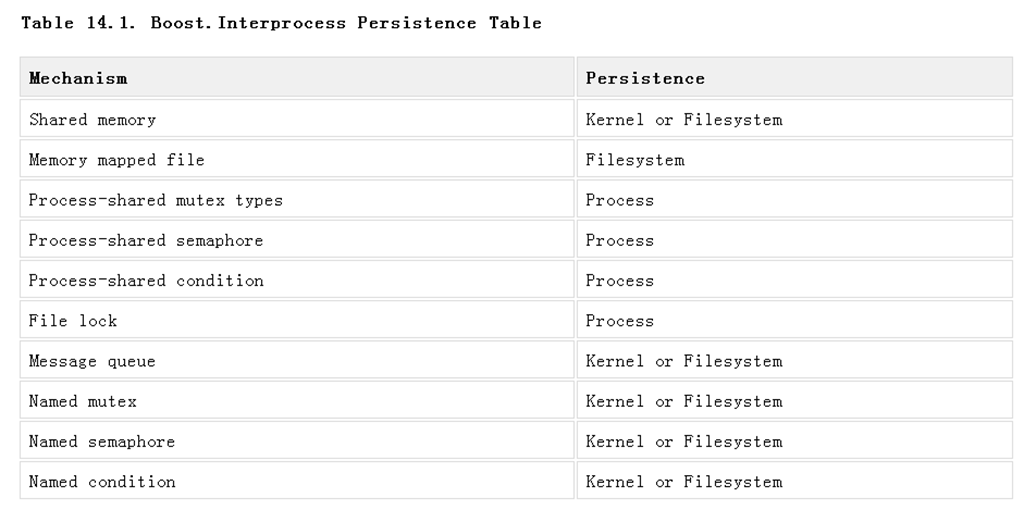Boost IPC Persistence Of Interprocess Mechanisms 例子
下面这一段摘抄自 Boost 1_55_0 的文档,显然标注了 每一个的生命期。
One of the biggest issues with interprocess communication mechanisms is the lifetime of the interprocess communication mechanism. It's important to know when an interprocess communication mechanism disappears from the system. In Boost.Interprocess, we can have 3 types of persistence:
- Process-persistence: The mechanism lasts until all the processes that have opened the mechanism close it, exit or crash.
- Kernel-persistence: The mechanism exists until the kernel of the operating system reboots or the mechanism is explicitly deleted.
- Filesystem-persistence: The mechanism exists until the mechanism is explicitly deleted.
Some native POSIX and Windows IPC mechanisms have different persistence so it's difficult to achieve portability between Windows and POSIX native mechanisms. Boost.Interprocess classes have the following persistence:

As you can see, Boost.Interprocess defines some mechanisms with "Kernel or Filesystem" persistence. This is because POSIX allows this possibility to native interprocess communication implementations. One could, for example, implement shared memory using memory mapped files and obtain filesystem persistence (for example, there is no proper known way to emulate kernel persistence with a user library for Windows shared memory using native shared memory, or process persistence for POSIX shared memory, so the only portable way is to define "Kernel or Filesystem" persistence).
最好的是下面这一个简单的example。
#include <boost/interprocess/shared_memory_object.hpp>
#include <boost/interprocess/mapped_region.hpp>
#include <cstring>
#include <cstdlib>
#include <string>
int main(int argc, char *argv[])
{
using namespace boost::interprocess;
if(argc == 1){ //Parent process
//Remove shared memory on construction and destruction
struct shm_remove
{
shm_remove() { shared_memory_object::remove("MySharedMemory"); }
~shm_remove(){ shared_memory_object::remove("MySharedMemory"); }
} remover;
//Create a shared memory object.
shared_memory_object shm (create_only, "MySharedMemory", read_write);
//Set size
shm.truncate(1000);
//Map the whole shared memory in this process
mapped_region region(shm, read_write);
//Write all the memory to 1
std::memset(region.get_address(), 1, region.get_size());
//Launch child process
std::string s(argv[0]); s += " child ";
if(0 != std::system(s.c_str()))
return 1;
}
else{
//Open already created shared memory object.
shared_memory_object shm (open_only, "MySharedMemory", read_only);
//Map the whole shared memory in this process
mapped_region region(shm, read_only);
//Check that memory was initialized to 1
char *mem = static_cast<char*>(region.get_address());
for(std::size_t i = 0; i < region.get_size(); ++i)
if(*mem++ != 1)
return 1; //Error checking memory
}
return 0;
}
.csharpcode, .csharpcode pre
{
font-size: small;
color: black;
font-family: consolas, "Courier New", courier, monospace;
background-color: #ffffff;
/*white-space: pre;*/
}
.csharpcode pre { margin: 0em; }
.csharpcode .rem { color: #008000; }
.csharpcode .kwrd { color: #0000ff; }
.csharpcode .str { color: #006080; }
.csharpcode .op { color: #0000c0; }
.csharpcode .preproc { color: #cc6633; }
.csharpcode .asp { background-color: #ffff00; }
.csharpcode .html { color: #800000; }
.csharpcode .attr { color: #ff0000; }
.csharpcode .alt
{
background-color: #f4f4f4;
width: 100%;
margin: 0em;
}
.csharpcode .lnum { color: #606060; }
在主进程中创建另一个进程,这个进程来验证之前的共享内存是否被初始化为1。 因为我们的shared memory的生命期是 Kernel 或者是filesystem,所以进程2 是可以验证的。 值得注意一点的是这里的remover,他是一个栈对象,所以每次都销毁,显式调用了 remove,如果去掉这个remover,那么只需要执行一次,以后每次输入这个显式内存都是存在的。因为他的生命期是 kernel 或者filesystem。 所以这里的remover 至关重要!
Boost IPC Persistence Of Interprocess Mechanisms 例子的更多相关文章
- IPC介绍——10个ipcs例子
IPC介绍——10个ipcs例子 semaphorearrays2010performancesystemaccess ipcs是一个uinx/linux的命令.用于报告系统的消息队列.信号量.共享内 ...
- boost库asio详解8——几个TCP的简单例子
摘于boost官网的几个例子, 做了点小修改, 笔记之. 同步客户端 void test_asio_synclient() { typedef boost::asio::io_service IoSe ...
- BOOST 线程完全攻略 - 基础篇
http://blog.csdn.net/iamnieo/article/details/2908621 2008-09-10 12:48 9202人阅读 评论(3) 收藏 举报 thread多线程l ...
- [C++Boost]程序参数项解析库Program_options使用指南
介绍 程序参数项(program options)是一系列name=value对,program_options 允许程序开发者获得通过命令行(command line)和配置文件(config fi ...
- boost::thread类
前言 标准C++线程即将到来.预言它将衍生自Boost线程库,现在让我们探索一下Boost线程库. 几年前,用多线程执行程序还是一件非比寻常的事.然而今天互联网应用服务程序普遍使用多线程来提高与多客户 ...
- Android查缺补漏(IPC篇)-- 进程间通讯基础知识热身
本文作者:CodingBlock 文章链接:http://www.cnblogs.com/codingblock/p/8479282.html 在Android中进程间通信是比较难的一部分,同时又非常 ...
- System V IPC 之共享内存
IPC 是进程间通信(Interprocess Communication)的缩写,通常指允许用户态进程执行系列操作的一组机制: 通过信号量与其他进程进行同步 向其他进程发送消息或者从其他进程接收消息 ...
- 详解 boost 库智能指针(scoped_ptr<T> 、shared_ptr<T> 、weak_ptr<T> 源码分析)
一.boost 智能指针 智能指针是利用RAII(Resource Acquisition Is Initialization:资源获取即初始化)来管理资源.关于RAII的讨论可以参考前面的文章.在使 ...
- Boost总结汇总
从开始接触Boost已经有好几年了,而对它的掌握却难言熟悉,有对它部分的源代码的剖析也是蜻蜓点水.有时间一点点梳理一下吧. 1. 概述 [Boost]C++ Boost库简介[Boost]C++ Bo ...
随机推荐
- 【转】 使用Beaglebone Black的PRU(三)——实现高达100MHz的GPIO输出
友情提示:请先按照本系列(一)(二)的说明安装PRU工具并跑通hello world再继续按本文操作. PRU操作GPIO有很多种方式,本系列之(二)中的是一种,但最快速的方式是通过直接“写”r30和 ...
- Asp.Net 5使用第三方容器
这几天在学习Asp.Net 5,现在文档以及博客之类的资料实在太少了,不看源码几乎举步维艰,好在全都是开源的,看看微软的代码也获益良多. 看到DependencyInjection的代码里除了默认的容 ...
- TCP/IP协议原理与应用笔记04:子网掩码
1. 子网掩码 是IP 参照物:分网段用的! 比如 192.168.0.1 和192.168.0.2(1).子网掩码为 255.255.255.0那么192.168.0.X 在同一个网段,能互相访问. ...
- Java 开源分布式缓存框架Ehcache
http://www.codeceo.com/article/java-ehcache.html
- 常用CentOS 6/7 扩展源
1.系统自带 baseextrasupdates 2.epel yum install epel-release https://fedoraproject.org/wiki/EPEL 3.el(用于 ...
- 如何在ios手机端的Safari浏览器 中“查看网页源代码”
在这里给大家分享一个很简单的用苹果手机无需越狱就可以查看网页源代码的方法,不过这个方法只用于苹果手机自带的Safari浏览器 随便添加一个safari 书签 (用于一会改为查看源码功能书签)进入书签 ...
- css布局模型之绝对定位与相对定位
1. 绝对定位,absolute 如果想为元素设置层模型中的绝对定位,需要设置position:absolute(表示绝对定位),这条语句的作用将元素从文档流中拖出来,然后使用left.right.t ...
- 服务器的SVN项目版本较低,check out 下来后报错
check out下来后报错提示: svn: E155036: Please see the 'svn upgrade' commandsvn: E155036: Working copy '/hom ...
- 【转】Monkeyrunner测试1——Monkeyrunner的使用
Monkeyrunner的使用 一.终端输入单行命令行实现 1. 开启android 模拟器 (1) 用Eclipse打开andorid的模拟器 (2) 在CMD中用andorid命令打开模拟器 定位 ...
- Android MVP架构浅析
Android之MVC模式 MVC好处: 从用户的角度出发,用户可以根据自己的需求,选择自己合适的浏览数据的方式.比如说,对于一篇在线文档,用户可以选择以HTML网页的方式阅读,也可以选择以pdf的方 ...
